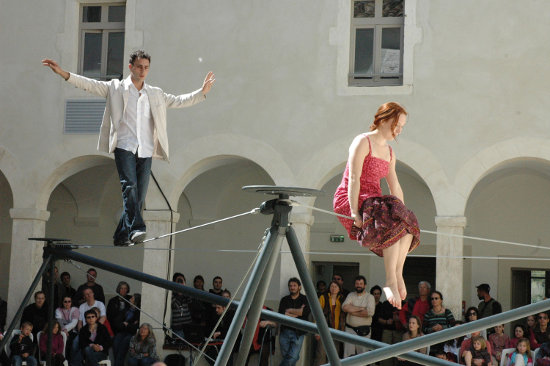
A member of the audience is stepping over the guard rope and posing in front of the Colporteurs’ rig, a confused triple wire structure where the underbeams run slanted to the ground, hitting a pose while her friend takes a picture. A flustered Watch This Space team coax her out, and she circles around awhile before creeping back in, not to be dissuaded. She and her friend lay hands on the structure, walk around inside it, and finally try to climb atop it, starting the Colporteurs’ piece Hautes Pointures. I’ll admit to realising very late that the two were plants, but it's easy to be taken in by their pitch perfect costumes and characters: chewing gum, trashy stylish, totally unembarrassed. They make a precarious ascent climbing the diagonal main bars in their high heels, clinging to each other for support, sliding down, a dropped handbag tumbling open to spray the WTS Astroturf with unmentionable personal items. At the top they walk the wire in heels, gradually with more confidence. Then, ditching the shoes, they run the wire with their bare feet—flat, loose and long. It’s a great piece of street art, exactly the right length, with a reveal that sets up a nice perspective shift—troublesome audience members to performers and awkward amateurs to high-skill wire-walkers.
Three hours later, after dark, Les Colporteurs’ second piece Tarina inhabited a different mode. There’s a sense in which tightwire is a very raw art: its technical workings are bound tightly with its aesthetic presentation. You see plenty of aerialists and acrobats who mask the physical difficulty of their work so that their body becomes a shape, a line, not a working tool—but with wire the effort of controlling balance and mastering the equipment is never invisible. In Tarina, a duet for a man and a woman, the struggle not just to keep but to regain balance is the heart of the piece: jumping from wire to wire the man pitches alarmingly forward and back; when together, the two both help and hinder each other—stepping over the other’s feet their progress is halting, but between themselves they can give and borrow stability. They stay on. There’s enough in Tarina to construct a relationship and a narrative if you feel you need to, but it’s broader and better than one interpretation—something fragile and bittersweet; a night journey—and I haven't seen many images more ravishing or evocative of romance and longing than Tarina's simplest: two people on wire, walking backwards toward each other.